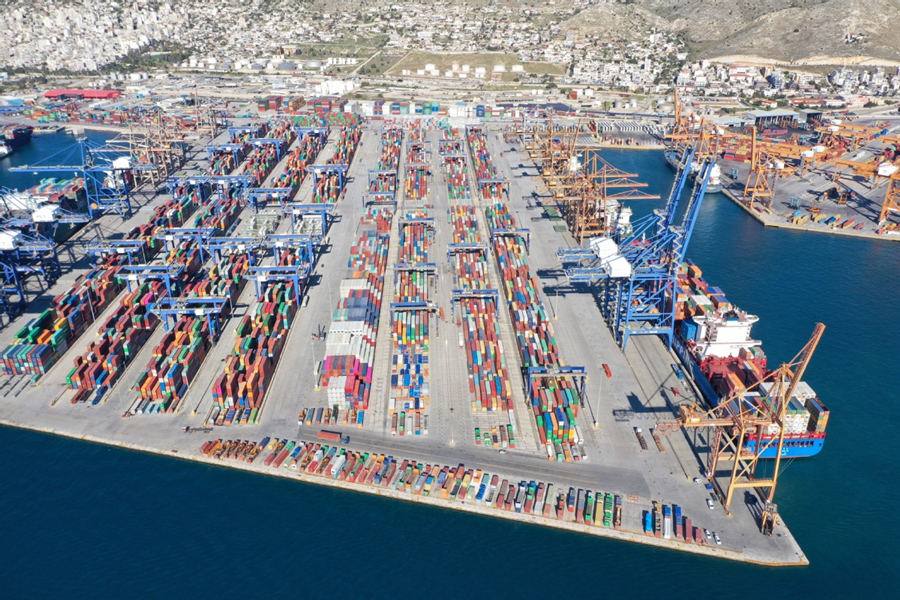BRI resilience shows China's role in recovery

Port of Piraeus, a major sea port in Athens, Greece, is operated by China COSCO Shipping Corp, and has become one of the world's fastest-growing container ports. [Photo/Xinhua]
In 2020, China and BRI-related countries worked hard to jointly advance infrastructure connectivity in an overall unfavorable environment. Many landmark Belt and Road projects achieved steady progress and substantive results, and "Constructed by China" has shown a strong brand effect in international cooperation, the report said.
China signed project contracts worth $141.46 billion with BRI economies in 2020, compared with $71.57 billion in 2013, registering an average annual growth rate of 10.2 percent. The completed turnover increased from $65.4 billion to $91.12 billion, reporting an average annual growth rate of 4.9 percent, the report stated.
Li Dongchun, director of the overseas business unit of Liugong Machinery Co Ltd, a Liuzhou, Guangxi Zhuang autonomous region-based machinery manufacturer, said the company has seen drastic growth in overseas business in recent years, thanks to rapidly growing BRI trade and economic cooperation.
The company's overseas sales of road construction equipment reached a record high of 600 units in the first half, surging 68 percent year-on-year.
Following the establishment of its Asia-Pacific headquarters in 2011 in Singapore, and a regional after-sales service center for the ASEAN region and the wider area of Asia-Pacific, the company set up a subsidiary in 2019 in Indonesia to focus on both trading and manufacturing in the country and further tap business opportunities in the Regional Comprehensive Economic Partnership region, as it believes the RCEP will significantly improve facilitation and liberalization of trade and investment in the area.
Improvements in connectivity between China and BRI economies have provided better support for the company's overseas operations, and soaring product demand from overseas, especially since 2016, is mainly due to a growing number of Chinese companies' overseas projects, as well as the increase in local appetite for infrastructure improvement, Li said.
The report highlighted the signing of the RCEP agreement last year, saying it will unlock huge market potential and inject strong impetus into regional and global growth.
With the RCEP, a negative-list approach will open up more investment sectors. Overall, liberalization of trade in goods is over 90 percent, and higher-level rules are adopted in trade facilitation, intellectual property rights protection, competition policy and government procurement.
The CAITEC report also stressed contributions from cross-border e-commerce to promote the circulation of supplies of contagion prevention materials and daily necessities in 2020.
The pandemic hurt traditional service sectors like tourism and catering hard. However, the online economy represented by door-to-door deliveries and online shopping has grown rapidly.
Consumption online is thriving as more consumers and sellers use e-commerce platforms to "buy globally" and "sell globally" at home, the report said.
However, despite the growth in overseas demand, challenges remain for Chinese companies due to pandemic uncertainty, said Li of Liugong Machinery.
"Prolonged payment schedules, restrictions on people flows and logistic disruptions all add difficulties to overseas operations of Chinese machinery manufacturers," he said.
Othman Jerandi, Tunisia's minister of foreign affairs, migration and Tunisians abroad, said via video link during the opening ceremony of the Fifth China-Arab States Expo that the BRI will bring new opportunities for economic and trade cooperation to countries and regions involved in the BRI, including Tunisia. The expo opened in Yinchuan, capital of the Ningxia Hui autonomous region, on Aug 19 and closed on Aug 22.
The building of the BRI requires joint efforts from all parties, he said.
Tunisia is looking forward to strengthening cooperation with China, he added.
























